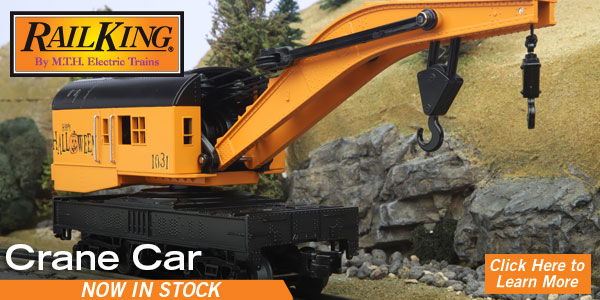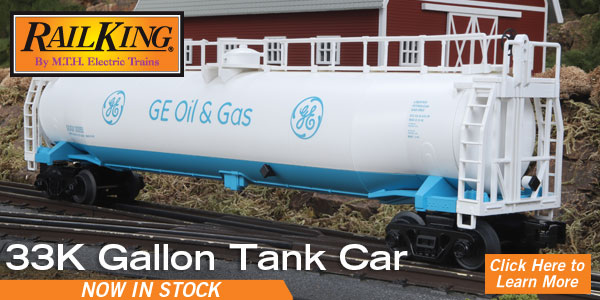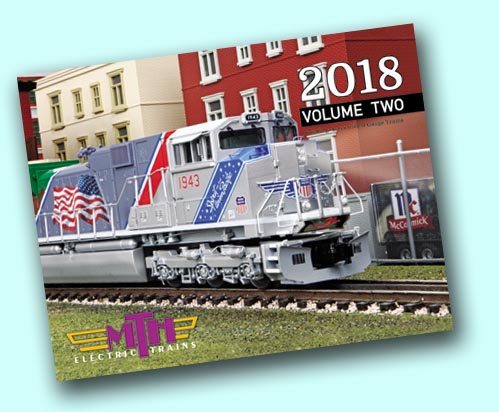 |
|||||||
|
|||||||

In the early days of railroading, the job of cleaning up a wreck was usually done by men and horses. The first steam wrecking crane, a relatively small affair with a 20-ton lifting capacity, appeared in 1883. Its maker, Industrial Works of Bay City Michigan, introduced a fully revolving model a decade later. As the product became popular, Industrial Works, now renamed Industrial Brownhoist, and its chief competitor, Bucyrus-Erie of South Milwaukee, introduced larger and larger models to cope with increasing locomotive and car weights. By the World War I era, steam-powered cranes of 120-ton capacity, like our RailKing model, were a common size. While a wreck train on the way to a wreck had priority over other traffic, cranes were subject to rather low speed restrictions, typically around 35 mph with the boom trailing and 25 mph if the boom was facing forward. The larger hook closer to the cab was actually the main lifting hook, used for locomotives. The hook at the end of the boom was a lower-capacity auxiliary hook, used when more reach was needed. Slings, chains, and spreader bars were used to attach the hook to the car or locomotive being lifted; the hooks were never attached directly. While some cranes were capable of limited self-propulsion, that was only for positioning at a site, not for travel to and from wrecks or jobs. The tank car was relatively uncommon until the 1870s, when the nascent petroleum industry ordered large quantities of metal tanks carried on wooden car bodies. By the early 1900s, a standard design had evolved that lasted throughout the steam and early diesel eras: an 8,000-11,000 gallon metal tank perched on a metal flatcar-like underframe. The one big change during that time was the transition from riveted to welded construction, beginning in the late 1930s. Car builders introduced X-ray inspection of welds to ensure safety, as well as giant annealing ovens that could heat-treat assembled tanks to relieve joint stress. Welded tanks were stronger, less susceptible to rust and corrosion, and less likely to rupture in the event of a wreck. At the same time as steam engines were disappearing, another innovation completely changed the appearance of tank cars. Beginning in the mid-1950s, a new design took hold: the tank itself became the structural backbone of the car, eliminating the need for a full-length underframe and making bigger tank diameters possible. Stub sills under each end provided a place to mount trucks and couplers. The prototype for this car was one of the largest tank cars in regular service, a pressurized 33,000 gallon car used for transporting liquefied petroleum gas, a byproduct of oil refining used for home and industrial heating. Another common payload for these cars was anhydrous ammonia, a highly concentrated fertilizer. The first of these cars was built for Shippers car Line (SHPX) in 1962 by American Car and Foundry (ACF). To provide maximum capacity within the allowed loading gauge (outside dimensions), it featured a dual-diameter tank, with a smaller diameter over the stub end sills and a larger diameter between the sills — giving rise to the nickname "whalebelly." Cars of this type were built throughout the 1960s and initially decorated in flamboyant paint schemes — until public concerns about the safety of flammable cargos led owners and lessees to opt for more subdued decoration. In the 1970s, however, the whalebelly design was largely replaced by single-diameter cars of the same capacity. Many original whalebellies served into the first decade of this century, until the end of their allowed 40-year service life. High quality, traditionally sized RailKing Freight Cars provide detailed bodies and colorful paint schemes for the O Gauge railroader. MTH makes an enormous variety of RailKing Freight Cars, including many different car types and roadnames. No matter what era or part of the country you are modeling, RailKing is sure to have something for you. |
2018 Volume 2 CatalogClick HERE to see it online. It's Easy To Add WiFi To Your DCS LayoutCheck Out The Quick Start VideoClick HERE To Learn More About DCS and WiFi Control M.T.H. Electric Trains is releasing a limited run of smartphone cases for popular iPhone and Samsung Galaxy models this Fall. Club Members save $5.00 off the regular suggested retail of $15.99 each. These durably constructed cases feature a reinforced corner design for drop protection. Its flexible sides, knurled grip, and integrated buttons provide you with an elevated, rugged look while providing complete protection for your device. Click HERE to learn more. Don't miss this opportunity to show off your M.T.H. pride. To order your case today, call the M.T.H. Sales Department at 410-381-2580 (option 1) and reserve yours. |
||||||
| Follow Us On | |||||||
| © 2018 M.T.H. Electric Trains 7020 Columbia Gateway Drive, Columbia, MD 21046 (410)381-2580 |
|||||||






